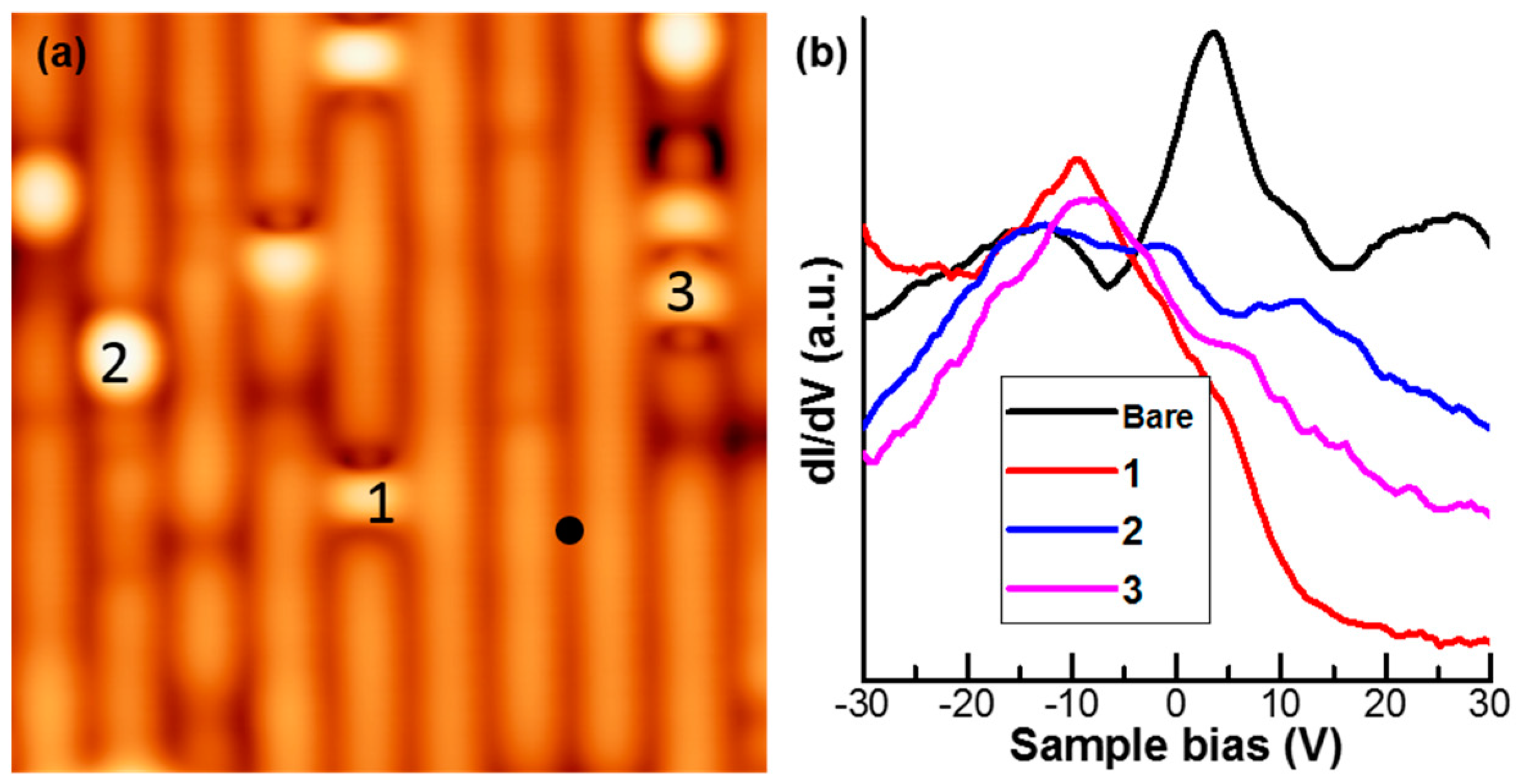Nanoscale Superconducting States in the Fe-Based Filamentary Superconductor of Pr-Doped CaFe2As2
Abstract
:1. Introduction
2. Materials and Methods
3. Results and Discussion
4. Conclusions
Author Contributions
Funding
Institutional Review Board Statement
Informed Consent Statement
Data Availability Statement
Acknowledgments
Conflicts of Interest
Disclaimer
References
- Mandrus, D.; Sefat, A.S.; McGuire, M.A.; Sales, B.C. Materials chemistry of BaFe2As2: A model platform for unconventional superconductivity. Chem. Mater. 2010, 22, 715–723. [Google Scholar] [CrossRef]
- Hoffman, J.E. Spectroscopic scanning tunneling microscopy insights into Fe-based superconductors. Rep. Prog. Phys. 2011, 74, 124513. [Google Scholar] [CrossRef] [Green Version]
- Gofryk, K.; Pan, M.; Cantoni, C.; Saparov, B.; Mitchell, J.E.; Sefat, A.S. Local inhomogeneity and filamentary superconductivity in Pr-doped CaFe2As2. Phys. Rev. Lett. 2014, 112, 047005. [Google Scholar] [CrossRef] [PubMed] [Green Version]
- Zeljkovic, I.; Huang, D.; Song, C.-L.; Lv, B.; Chu, C.-W.; Hoffman, J.E. Nanoscale surface element identification and dopant homogeneity in the high-T c superconductor PrxCa1−xFe2As2. Phys. Rev. B 2013, 87, 201108. [Google Scholar] [CrossRef] [Green Version]
- Xiao, H.; Hu, T.; He, S.K.; Shen, B.; Zhang, W.J.; Xu, B.; He, K.F.; Han, J.; Singh, Y.P.; Wen, H.H.; et al. Filamentary superconductivity across the phase diagram of Ba(Fe,Co)(2)As-2. Phys. Rev. B 2012, 86, 064521. [Google Scholar] [CrossRef] [Green Version]
- Moseley, D.; Yates, K.A.; Branford, W.R.; Sefat, A.S.; Mandrus, D.; Stuard, S.J.; Salem-Sugui, S.; Ghivelder, L.; Cohen, L.F. Signatures of filamentary superconductivity in antiferromagnetic BaFe2As2 single crystals. Epl-Europhys Lett. 2015, 111, 37005. [Google Scholar] [CrossRef] [Green Version]
- Sefat, A.S. Bulk synthesis of iron-based superconductors. Curr. Opin. Solid St M 2013, 17, 59–64. [Google Scholar] [CrossRef] [Green Version]
- Saha, S.R.; Butch, N.P.; Drye, T.; Magill, J.; Ziemak, S.; Kirshenbaum, K.; Zavalij, P.Y.; Lynn, J.W.; Paglione, J. Structural collapse and superconductivity in rare-earth-doped CaFe2As2. Phys. Rev. B 2012, 85, 024525. [Google Scholar] [CrossRef] [Green Version]
- Qi, Y.; Gao, Z.; Wang, L.; Wang, D.; Zhang, X.; Yao, C.; Wang, C.; Wang, C.; Ma, Y. Transport properties and anisotropy in rare-earth doped CaFe2As2 single crystals with Tc above 40 K. Supercond. Sci. Technol. 2012, 25, 045007. [Google Scholar] [CrossRef] [Green Version]
- Zhou, W.; Shi, Z. Review on origin of the unusual high-Tc superconductivity in Ca1−xRExFe2As2 (RE= La, Ce, Pr, Nd). Novel Supercond. Mater. 2015, 1. [Google Scholar] [CrossRef] [Green Version]
- Zou, Q.; Wu, Z.M.; Fu, M.M.; Zhang, C.M.; Rajput, S.; Wu, Y.P.; Li, L.; Parker, D.S.; Kang, J.; Sefat, A.S.; et al. Effect of Surface Morphology and Magnetic Impurities on the Electronic Structure in Cobalt-Doped BaFe2As2 Superconductors. Nano Lett. 2017, 17, 1642–1647. [Google Scholar] [CrossRef] [PubMed] [Green Version]
- Sefat, A.S.; Nguyen, G.D.; Parker, D.S.; Fu, M.M.M.; Zou, Q.; Li, A.P.; Cao, H.B.B.; Sanjeewa, L.D.; Li, L.; Gai, Z. Local superconductivity in vanadium iron arsenide. Phys. Rev. B 2019, 100, 104525. [Google Scholar] [CrossRef] [Green Version]
- Saha, S.; Butch, N.; Kirshenbaum, K.; Paglione, J.; Zavalij, P. Superconducting and ferromagnetic phases induced by lattice distortions in stoichiometric SrFe2As2 single crystals. Phys. Rev. Lett. 2009, 103, 037005. [Google Scholar] [CrossRef] [PubMed] [Green Version]
- Engelmann, J.; Grinenko, V.; Chekhonin, P.; Skrotzki, W.; Efremov, D.; Oswald, S.; Iida, K.; Hühne, R.; Hänisch, J.; Hoffmann, M. Strain induced superconductivity in the parent compound BaFe2As2. Nat. Commun. 2013, 4, 2877. [Google Scholar] [CrossRef] [PubMed]
- Xiao, H.; Hu, T.; Dioguardi, A.; Shockley, A.; Crocker, J.; Nisson, D.; Viskadourakis, Z.; Tee, X.; Radulov, I.; Almasan, C. Evidence for filamentary superconductivity nucleated at antiphase domain walls in antiferromagnetic CaFe2As2. Phys. Rev. B 2012, 85, 024530. [Google Scholar] [CrossRef] [Green Version]
- Ozaki, T.; Wu, L.; Zhang, C.; Jaroszynski, J.; Si, W.; Zhou, J.; Zhu, Y.; Li, Q. A route for a strong increase of critical current in nanostrained iron-based superconductors. Nat. Commun. 2016, 7, 13036. [Google Scholar] [CrossRef] [PubMed] [Green Version]
- Mizuguchi, Y.; Hara, Y.; Deguchi, K.; Tsuda, S.; Yamaguchi, T.; Takeda, K.; Kotegawa, H.; Tou, H.; Takano, Y. Anion height dependence of Tc for the Fe-based superconductor. Supercond. Sci. Technol. 2010, 23, 054013. [Google Scholar] [CrossRef] [Green Version]
- Deng, L.; Lv, B.; Zhao, K.; Wei, F.; Xue, Y.; Wu, Z.; Chu, C. Evidence for defect-induced superconductivity up to 49 K in (Ca1−xRx)Fe2As2. Phys. Rev. B 2016, 93, 054513. [Google Scholar] [CrossRef] [Green Version]





Publisher’s Note: MDPI stays neutral with regard to jurisdictional claims in published maps and institutional affiliations. |
© 2021 by the authors. Licensee MDPI, Basel, Switzerland. This article is an open access article distributed under the terms and conditions of the Creative Commons Attribution (CC BY) license (https://creativecommons.org/licenses/by/4.0/).
Share and Cite
Nguyen, G.D.; Fu, M.; Zou, Q.; Sanjeewa, L.D.; Li, A.-P.; Sefat, A.S.; Gai, Z. Nanoscale Superconducting States in the Fe-Based Filamentary Superconductor of Pr-Doped CaFe2As2. Nanomaterials 2021, 11, 1019. https://doi.org/10.3390/nano11041019
Nguyen GD, Fu M, Zou Q, Sanjeewa LD, Li A-P, Sefat AS, Gai Z. Nanoscale Superconducting States in the Fe-Based Filamentary Superconductor of Pr-Doped CaFe2As2. Nanomaterials. 2021; 11(4):1019. https://doi.org/10.3390/nano11041019
Chicago/Turabian StyleNguyen, Giang D., Mingming Fu, Qiang Zou, Liurukara D. Sanjeewa, An-Ping Li, Athena S. Sefat, and Zheng Gai. 2021. "Nanoscale Superconducting States in the Fe-Based Filamentary Superconductor of Pr-Doped CaFe2As2" Nanomaterials 11, no. 4: 1019. https://doi.org/10.3390/nano11041019
APA StyleNguyen, G. D., Fu, M., Zou, Q., Sanjeewa, L. D., Li, A.-P., Sefat, A. S., & Gai, Z. (2021). Nanoscale Superconducting States in the Fe-Based Filamentary Superconductor of Pr-Doped CaFe2As2. Nanomaterials, 11(4), 1019. https://doi.org/10.3390/nano11041019






